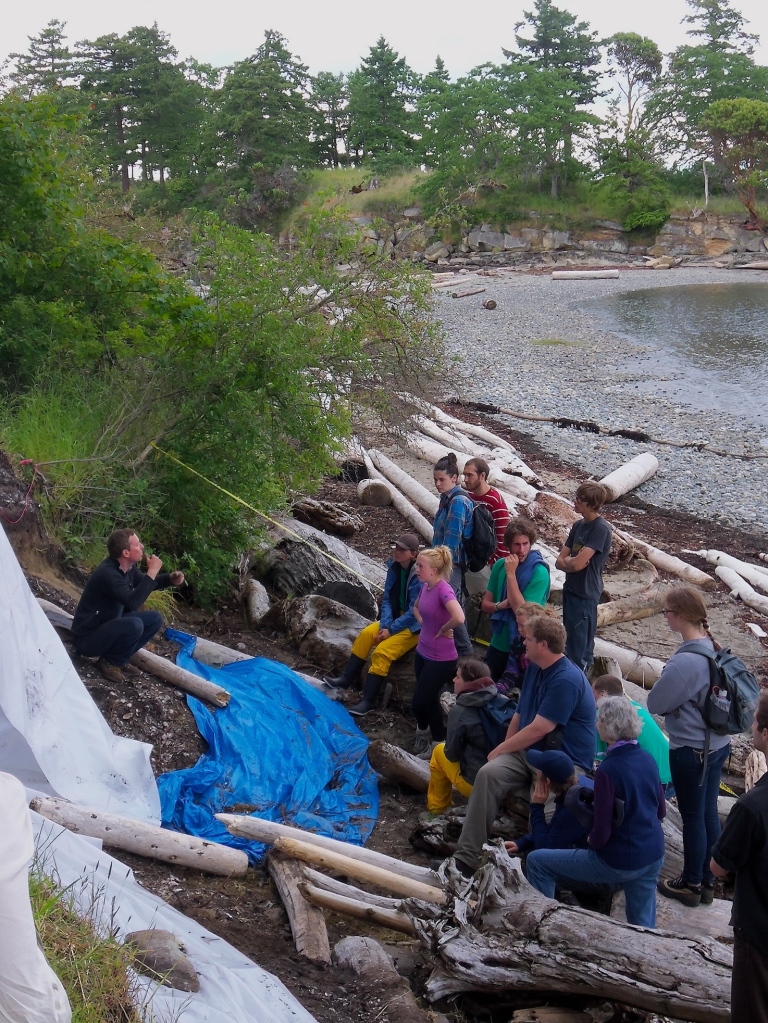Colin Grier’s archeological studies explore how indigenous societies adapted to social and ecological change.
For thousands of years, numerous small-scale societies, mostly coastal hunting, gathering and fishing peoples, populated the Pacific Northwest. What remains of these small-scale societies, and what we can learn from them as they transformed from more mobile, small groups to larger, more complex societies—specifically, how they have adapted and survived—form the basis of Colin Grier’s life’s work.
Grier is professor of archeology in the Department of Anthropology at Washington State University Vancouver. His primary field work has been investigating the archeological record of the Southern Gulf Islands of British Columbia.

Grier, a Canadian who earned his bachelor’s degree at McGill University and his master’s and Ph.D. at Arizona State University, joined WSU in 2007. He was based in Pullman for about 12 years before moving to the Vancouver campus to be closer to the coastal areas where he works. He also does field research on other similarly-scaled societies around the world, such as those of ancient Korea and Japan, looking for commonalities.
Grier’s research is extraordinarily timely. His interdisciplinary approach embraces questions of social complexity, sustainability, climate change and ecological restoration. He works through collaborative relationships and partnerships with the indigenous people whose history he studies. He argues that a lot can be drawn from studying the ways people in the past adapted to environmental and social change. The job of archeologists is to uncover those successful strategies and translate how they can be applied today.
As he wrote in a 2017 article titled “Looking to the past to shape the future,” in the journal Regional Environmental Change, “Humans have made decisions and implemented new practices in the past in ways that may appear dissimilar to our modern context, but which can inform policy and meet our own sustainability challenges.”
What can we learn? “How people engage their environments in different ways than we have. Settled village life means people are staying put and can have significant impacts on their environment. Northwest Coast people were sustainable in these places for thousands of years. What were they doing differently than we are now? We have a lot to learn about ways we might manage ecologies, not only environmentally but socially,” Grier said.
A good example of this on a practical level can be found close to home. Grier is a member of the Science Panel for the Puget Sound Partnership, a Washington state agency tasked with restoring Puget Sound. He was a lead author on the Science Panel’s statement in the “State of the Sound 2021” report on how we need to go forward ecologically. The report cites a number of accomplishments in a long-term effort to clean up the Sound. As the Science Panel statement notes: “Puget Sound recovery does not mean returning to a Sound that existed in 1950, in 1850, or 10,000 years ago.” Rather, it is about making decisions that are “guided by history but not attempting to recreate the past.”
Ground-penetrating radar: An important archeological tool
A more recent theme in Grier’s work is the use of GPR—ground-penetrating radar. He has used it in his work for about a decade and has a National Science Foundation grant to explore its possibilities in locating and surveying households and villages.
GPR, a tool commonly used by builders and surveyors that deploys electromagnetic waves to penetrate the ground in search of hidden objects, can also help map village locations. “I focus on village locations because to me that is the nexus through which Indigenous peoples have engaged their environment,” Grier said. “If we can map changing households and communities, we can better understand how they were organized to confront ecological challenges.”

GPR made headlines last summer for its use in uncovering unmarked human burial sites at Indian residential schools across Canada. Grier had worked as an archival historian for the Canadian government before joining WSU, documenting the history of the residential schools and helping to process tribal claims. Recent examples of GPR being used at residential schools are bringing his current NSF-funded work and past research together once again. Archaeologists with knowledge of the technology and school histories can help facilitate the hard work that will advance reconciliation and healing.
There were 367 such schools in the United States. including 13 in Washington and 9 in Oregon. “A national conversation is needed,” Grier said. “Archeologists have expertise. We work collaboratively with communities generally.”
In the Vancouver area, Grier and his students are also using GPR as part of a longstanding collaboration with the National Park Service and Portland State University at Fort Vancouver. GPR can reveal ancient and more recent community organization without extensive excavation, allowing us to reframe questions about the site. “People think of it as a colonial fort,” he said, “but it’s also a long-standing indigenous place. I like to think broadly about the fort locale and how it represents a deeper indigenous connection to this landscape.”

Consider that indigenous people navigated this landscape for 14,000 years. “Fort Vancouver represents a transition point,” he said, “when indigenous living transformed rapidly.”For Grier, contributing to contemporary decisions is the overarching purpose of archeology. “We need to look in many places for ideas of how to do things differently,” Grier said. “Looking to people who’ve been here 14,000 years is an important part of the conversation.”
